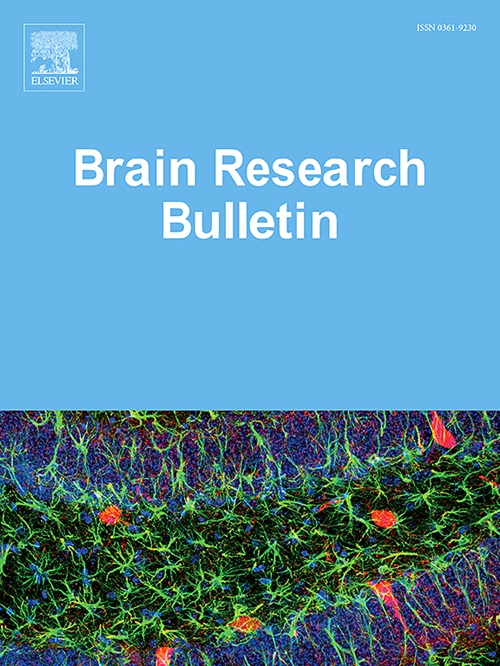识别偏头痛患者功能连接和大脑网络拓扑的非对称异常:基于静息态 fMRI 数据的初步研究。
IF 3.5
3区 医学
Q2 NEUROSCIENCES
引用次数: 0
摘要
利用fMRI研究偏头痛患者大脑不对称的神经机制尚不充分。本研究建议使用功能连接和脑网络拓扑的侧向化算法,并研究偏头痛患者的侧向化变化。在研究1中,定义了功能连接的侧向性指数(LFunctionCorr)和脑网络拓扑特性(LBetweennessCentrality、LDegree和LStrength)。比较了偏头痛患者和正常人在全脑、半脑和区域水平上的差异。在研究 2 中,偏侧性指数被用于对偏头痛进行分类,并通过独立样本和区段法对其重复性进行了验证。在研究 3 中,根据分类结果和差异分析提取了与偏头痛相关的异常脑区。研究1发现,在全脑水平上,偏头痛的相关脑区没有明显差异;但在半脑水平上,LFunctionCorr的半球侧化有明显差异,而在脑区水平上,也发现了11个明显不同的脑区。此外,研究 2 的分类准确率为 0.9366。经过反复验证,准确率达到了 0.8561。此外,根据分割策略扩展样本后,分类准确率提高到了 0.9408 和 0.8585。研究3根据侧向性指数确定了10个具有非对称性特异性的关键脑区,它们分布在视觉网络、前顶叶控制网络、默认模式网络、显著性/内省注意网络和边缘系统。研究结果揭示了偏头痛不对称机制的新见解和研究途径,并表明侧向性指数可用作偏头痛的潜在影像诊断标记。本文章由计算机程序翻译,如有差异,请以英文原文为准。
Identification of asymmetrical abnormalities in functional connectivity and brain network topology for migraine sufferers: A preliminary study based on resting-state fMRI data
Research on the neural mechanisms underlying brain asymmetry in patients with migraine patients using fMRI is insufficient. This study proposed using lateralized algorithms for functional connectivity and brain network topology and investigated changes in their lateralization in patients with migraine. In study 1, laterality indices of functional connectivity (LFunctionCorr) and brain network topological properties (LBetweennessCentrality, LDegree, and LStrength) were defined. Differences between migraineurs and normal subjects were compared at whole-brain, half-brain, and region levels. In study 2, laterality indices were used to classify migraine and were validated using independent samples and the segment method for repeatability. In study 3, abnormal brain regions related to migraine were extracted based on the classification results and differences analysis. Study 1 found no significant differences related to in for migraine at the whole-brain level; however, significant differences were identified at the half-brain level for the hemispheric lateralization of the LFunctionCorr, while 11 significantly different brain regions were also identified at the brain region level. Furthermore, the classification accuracy in study 2 was 0.9366. With repeated validation, the accuracy reached 0.8561. Furthermore, after extending the samples according to the segmentation strategy, the classification accuracies were improved to 0.9408 and 0.8585. Study 3 identified 10 crucial brain regions with asymmetrical specificity based on laterality indices distributed across the visual network, the frontoparietal control network, the default mode network, the salience/ventral attention network and the limbic system. The results revealed novel insights and avenues for research into the mechanisms of migraine asymmetry and showed that the laterality indices could be used as a potential diagnostic imaging marker for migraine.
求助全文
通过发布文献求助,成功后即可免费获取论文全文。
去求助
来源期刊

Brain Research Bulletin
医学-神经科学
CiteScore
6.90
自引率
2.60%
发文量
253
审稿时长
67 days
期刊介绍:
The Brain Research Bulletin (BRB) aims to publish novel work that advances our knowledge of molecular and cellular mechanisms that underlie neural network properties associated with behavior, cognition and other brain functions during neurodevelopment and in the adult. Although clinical research is out of the Journal''s scope, the BRB also aims to publish translation research that provides insight into biological mechanisms and processes associated with neurodegeneration mechanisms, neurological diseases and neuropsychiatric disorders. The Journal is especially interested in research using novel methodologies, such as optogenetics, multielectrode array recordings and life imaging in wild-type and genetically-modified animal models, with the goal to advance our understanding of how neurons, glia and networks function in vivo.
 求助内容:
求助内容: 应助结果提醒方式:
应助结果提醒方式:


